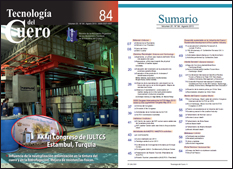| HOME | EDITORIAL | BOARD | GOALS | HISTORY | INTERNATIONAL EVENTS | ARTICLES | ANUAL REPORT | CONTACT US |

EditorialEditorial nº 84Leather Technology Magazine |
EditorialDuring the last meeting of the GLCC (Global Leather
Coordinating Committeee), held in Hong Kong The attendants to the meeting discussed the
strengths and weaknesses of the Leather Industry. The key leather characteristic (and main strength)
is it is natural, renewable and beautiful. However, we see there is a lack of information or
incorrect information provided to the consumers One of the arguments used is "Carbon Footprint
of Leather" and more recently still, "Water Footprint This analysis covers all life cycle activities of a
product (from procurement of raw materials to disposal
as waste), measuring the contribution of each
of these activities to global warming, allowing consumers
decide what to buy based on the pollution generated
as a result of the processes carried out. The methodology applied until recently to calculate
the Carbon Footprint of leather, included cattle However, as the main objective of raising cattle is
not getting leather, but the production of meat, animal
skin, which then will be leather, turns from being
waste to be a byproduct of other industry input.
Therefore, the current position to calculate the Carbon
Footprint, held by Federico Brugnoli, international
expert in the field, responsible for writing
UNIDO technical report on leather and carbon emissions
is, the Leather life cycle starts where the animal
is slaughtered, not including the breeding of cattle. Thus, the leather, Carbon Footprint is substantially
smaller revealing the positive impact that the use of Cotance is promoting a pilot study to calculate the
Carbon Footprint in different countries, which is supported
by major organizations related to the leather
industry worldwide. Lic. Patricia Casey - Presidente Letter from the editorIn IULTCS International Congress, which took
place last May in Istanbul, Turkey, 66 technical and As in previous Congresses, it is clear the interest
and concern of the Institutes, Universities and research
centers for further study of clean technologies
and production processes environmentally friendly. On the other hand, there is concern about there is
no official list of Restricted and Prohibited Substances
for leather, associated with test methods suitable
for proper detection. Unfortunately, on many occasions, the long lists of
restricted and / or prohibited substances include several
ones that are not present in any type of leather
because chemical inputs used in the production process
does not contain and because they cannot be
the result of a chemical reaction happens during the
process. Nevertheless, it must justify his absence by analysis. Add to this the fact that some big brands, ask the
suppliers to make the determinations of some substances,
applying chemical analysis methods developed
for other materials such as plastic or fabrics
which lead to erroneous results and, in some cases, they make a business failed. The tanning industry should get as much information
as possible from their suppliers of chemical inputs,
in order to be sure what they are using in their
process and thus avoid the use of chemical substances
that can cause health problems for users or for
the environment, as well as, controlling the production
process to minimize the risk of any unwanted
chemical reaction from occurring. But on the other hand, it is imperative to narrow
the list of restricted and / or prohibited substances in It will include recognized testing methods for leather,
thus avoiding false positives that may impair Lic. Patricia Casey - Presidente |
NO COPYRIGHT |


